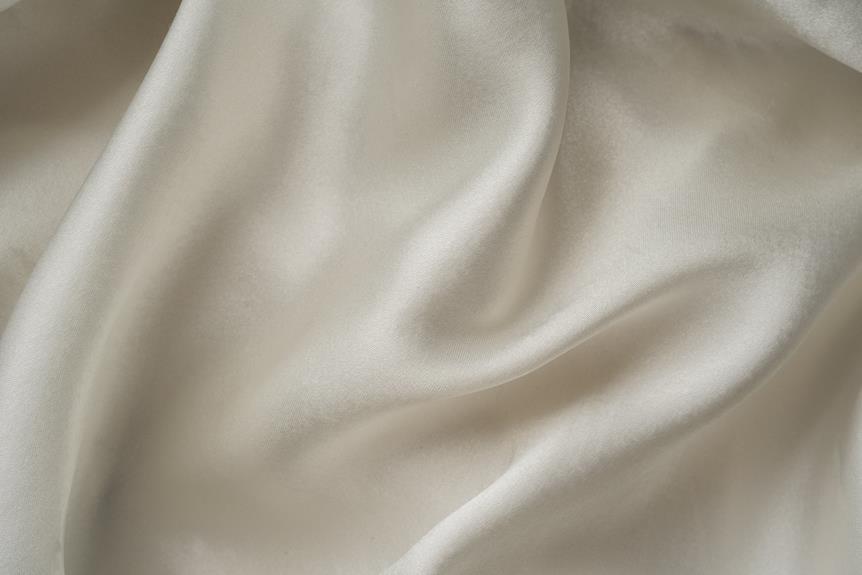If you're in the market for luxurious, versatile fabrics, you may find yourself torn between the smooth elegance of satin and the textured allure of crepe. Both fabrics have their own unique characteristics and advantages, making it a tough choice.
Understanding the differences and benefits of each will help you make an informed decision that suits your sewing project perfectly. From the drape and sheen of satin to the soft texture and ease of sewing with crepe, there are many factors to consider.
Let's explore the qualities of each fabric, compare their performance in different settings, and determine which one might be better suited to your needs.
Key Takeaways
- Satin fabric has a smooth, glossy surface and is popular for bridal gowns, evening dresses, and lingerie.
- Crepe fabric offers durability for everyday wear and a variety of textures, making it suitable for a wide range of garments and products.
- Satin is prone to showing water spots and wrinkles, while crepe fabric has a stylish draping with a crinkled texture.
- Crepe fabric is versatile and can be used for flowy dresses, skirts, blouses, scarves, headbands, accessories, cushion covers, and table linens.
Characteristics of Satin Fabric
When choosing between satin and crepe fabric, you'll notice that satin fabric stands out for its smooth, glossy surface and luxurious drape. The smooth, lustrous finish of satin is achieved through a weaving technique where the fibers are woven in a way that creates a high sheen on the front and a matte finish on the back. This gives satin a luxurious, elegant appearance that's highly sought after in formal wear and luxurious linens.
The way light reflects off the surface of satin fabric adds to its allure, making it a popular choice for bridal gowns, evening dresses, and lingerie.
In addition to its aesthetic appeal, satin fabric drapes beautifully, clinging to the body in a way that accentuates curves and creates a graceful silhouette. Its elegant drape adds a touch of sophistication to any garment, making it a favored choice for couture designs.
While satin fabric is undeniably stunning, it's important to consider its smooth surface and lustrous finish in relation to the specific needs of your project, as these characteristics can also make it more prone to showing water spots and wrinkles.
Advantages of Crepe Fabric
You'll appreciate that crepe fabric drapes effortlessly, giving your garments a chic and sophisticated flow. Crepe fabric offers numerous advantages that make it a popular choice for clothing and other textile products:
- Durability: Crepe fabric is known for its durability, making it a practical choice for everyday wear. The twisted yarns and unique weaving technique contribute to its strength, ensuring that garments made from crepe fabric can withstand regular use and washing without losing their shape or texture.
- Texture Options: Crepe fabric comes in a variety of textures, including crepe de Chine, Moroccan crepe, and georgette. Each type offers a distinct texture, allowing you to choose the one that best suits your preferences and the intended use of the fabric. Whether you desire a smooth, lightweight crepe or a more textured and substantial feel, there's a crepe fabric option to match your needs.
- Versatility: Crepe fabric is incredibly versatile, suitable for a wide range of garments and products. It drapes beautifully for elegant evening gowns, adds texture to blouses and dresses, and can even be used for home decor items like curtains and upholstery.
- Stylish Draping: The inherent crinkled texture of crepe fabric gives it a stylish and modern look, adding visual interest and dimension to any garment. Its ability to drape elegantly enhances the overall aesthetic, making it a favorite choice for designers and fashion enthusiasts.
Versatility in Sewing Projects
The versatility of crepe fabric makes it a popular choice for a wide range of sewing projects, allowing you to create garments, accessories, and home decor items with ease and style. Crepe fabric's unique characteristics, such as its subtle texture and beautiful drape, make it suitable for various sewing techniques and styles. Its ability to drape elegantly makes it perfect for creating flowy dresses, skirts, and blouses, while its lightweight nature also lends itself well to crafting scarves, headbands, and other accessories. Moreover, the fabric's versatility extends to home decor projects, as it can be used to make stylish curtains, cushion covers, and table linens.
To illustrate the versatility of crepe fabric in sewing projects, consider the following table:
| Sewing Project | Suitable Sewing Techniques | Fabric Drape |
|---|---|---|
| Flowy Dresses | Gathering, Draping | Beautifully |
| Scarves | Hemming, Rolled Hems | Elegant and Light |
| Cushion Covers | Piping, French Seams | Graceful |
Maintenance and Care Tips
To ensure the longevity of crepe fabric, proper maintenance and care are essential. Regularly inspecting for any signs of wear and following the recommended cleaning instructions will help preserve the fabric's quality and appearance.
When it comes to washing techniques, it's crucial to hand wash crepe fabric in cold water with a mild detergent to prevent damage to the delicate fibers. Avoid wringing or twisting the fabric and instead gently squeeze out excess water before air drying. Additionally, consider using a pressing cloth and ironing on a low heat setting when necessary to maintain the fabric's texture and appearance.
As for storage tips, store crepe fabric in a cool, dry place away from direct sunlight to prevent discoloration and weakening of the fibers. It's also advisable to avoid hanging crepe garments for extended periods to prevent stretching, and instead, fold them neatly to maintain their shape.
Comparison in Different Settings
When comparing satin and crepe fabric in different settings, consider the drape and sheen of each fabric to determine their suitability for various occasions.
Satin, with its luxurious sheen and smooth finish, is a perfect choice for formal events. Its elegant drape and lustrous appearance make it ideal for evening gowns, cocktail dresses, and formal blouses.
On the other hand, crepe fabric, with its subtle texture and matte finish, is more versatile and can transition effortlessly between day and night. Crepe is a great option for both casual and semi-formal settings. It works well for casual day dresses, skirts, and tops, as well as more relaxed evening wear. The understated elegance of crepe makes it a go-to choice for occasions where you want to look put together without being overly formal.
Ultimately, when deciding between satin and crepe, consider the formality of the event and the time of day. Satin leans towards formal evening events, while crepe offers a wider range of options, spanning from casual daywear to semi-formal evening attire.
Frequently Asked Questions
What Are the Historical Origins and Cultural Significance of Satin and Crepe Fabrics?
To understand the historical origins and cultural significance of satin and crepe fabrics, it's important to explore their roots in different regions and how they have evolved to represent various traditions and customs.
Are There Any Environmental or Ethical Considerations to Take Into Account When Choosing Between Satin and Crepe Fabric?
When choosing between satin and crepe fabric, consider their environmental impact and ethical sourcing. Satin's production often involves more chemicals and water, while crepe can be made from sustainable materials and ethical labor practices.
Can Satin and Crepe Fabrics Be Used for Upholstery and Home Decor Projects, in Addition to Clothing?
Yes, both satin and crepe fabrics can be used for upholstery and home decor projects. They offer versatility, suitable for various sewing techniques and dyeing options. Consider ethical and environmental impact, as well as cultural significance when choosing.
Are There Any Specific Techniques or Considerations for Sewing With Satin or Crepe Fabric That Are Not Mentioned in the Article?
When sewing with satin or crepe fabric, consider their unique properties. Use sharp needles and a walking foot to prevent snagging. Adjust tension and stitch length for optimal results. Experiment with different seam finishes.
Can Satin and Crepe Fabrics Be Dyed or Printed With Different Designs and Patterns?
Yes, you can dye and print both satin and crepe fabrics using various techniques. This allows for a wide range of design possibilities and pattern variations, making them versatile for creating unique and customized pieces.
- Tetron Fabric for Marine Applications: Durability and Use Cases - June 18, 2025
- Tetron Fabric for Outdoor Furniture: Weather Resistance and Care - June 18, 2025
- Tetron Fabric for Wall Coverings: Style and Application Tips - June 18, 2025



